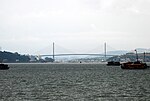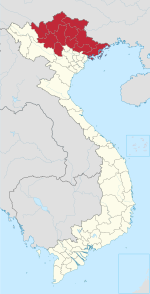Hạ Long
Hạ Long
Thành phố Hạ Long | |
|---|---|
| Hạ Long City | |
 | |
| Coordinates: 20°57′N 107°05′E / 20.950°N 107.083°E | |
| Country | Vietnam |
| Province | Quảng Ninh |
| Government | |
| • Type | People's Committee and People's Council |
| • Chairman of People's Council | Nguyễn Thế Thịnh |
| • Chairman of People's Committee | Phạm Hồng Hà |
| Area | |
| • Total | 271.95 km2 (105.00 sq mi) |
| Population (2013) | |
| • Total | 227,000 |
| • Density | 830/km2 (2,200/sq mi) |
| Climate | Cwa |
| Website | www |
Hạ Long (Vietnamese: [hâːˀ lawŋm] ) is the capital city and 1st-class provincial city of Quảng Ninh Province, Vietnam. The name Hạ Long means "descending dragon". The city was created in 1993, when the old capital, Hòn Gai, was merged with Bãi Cháy – the main tourist area. The city mainly lies on Hạ Long Bay. It is located at about 178 km east of Hanoi. The population in 2013 was 227,000.[1]
Overview
The city's economy has recently[when?] switched from coal mining to tourism, due to the large number of visitors drawn by the Hạ Long Islets every year. At present,[when?] Hạ Long is experiencing rapid growth not only in tourism sphere, but as a place upon the main road to southern China. In 2007 Vietnam-China Business Forum, a $400 million deal was signed to build a highway linking Hạ Long, Móng Cái and Quảng Ninh.
Hạ Long city is divided into two parts: East Hạ Long and West Hạ Long. The eastern part, Hòn Gai, where most of the official buildings and industry are concentrated, is connected by bridge with the western part, Bãi Cháy, considered to be more of a tourism attraction.
There are several good quality hotels in Hạ Long city and plenty of budget accommodation, two hospitals and several private medical centers.
The biggest hotel in Vietnam is planned to be built on the bay, beginning from 2007.
Etymology
The name Hạ Long is derived from the Sino-Vietnamese 下龍, meaning "descending dragon". For more about the origin of this name, see Hạ Long Bay.
Location
Being a coastal city, it has unique potentials of tourism and seaport due to its land lies along the shore of Hạ Long Bay of 50 km, and is 160 km to the north-east from Ha Noi, 60 km to the west from Hai Phong, 180 km to the east from Móng Cái international border gate, and bounded by the Gulf of Tonkin to the south. Hạ Long has strategic location of economic development, security of the region and the country.
Culture and society
In the south of the city there is Bai Tho (‘Poem’) Mountain with its almost vertical seaward face, which was widely used by some famous local poets. The limestone peak is rich in bio-diversity and offers attractive views of the bay. There are also such places of interest as Cua Van Fishing Village, Hoang Gia Park, Hạ Long Market, Bãi Cháy Trading Center, Quảng Ninh Museum, Vietnam-Japan Cultural House, Children's Cultural House.
Hạ Long city has an active Roman Catholic church in its eastern part, Hòn Gai, on the hill near the main post office, which holds the services on Sunday evenings and on Christian holidays.
History
Man has been present on Hạ Long Bay for a long time. Over the years, archaeologists, researchers concluded that during the application process of history, there were three cultures which called Soi Nhu, Hạ Long and Cai Beo culture. It shows that the bay and surrounding areas were one of the cradles of mankind. Heartland of today's Hạ Long City, formerly just a fishing village, called the Oyster Coast. By the beginning of the Nguyễn Dynasty, it was renamed to Mau Le. The east wards of the present city earlier belonged to Hoành Bồ District.
In 1883, the French occupied the bay area, they carried out coal mining in the mines on the Gulf Coast. As on many islands there was lots of hemp so French called Ile des brouilles or a name translated from Hon Gai to Hon Gay, later renamed Hon Gai. According to the researchers, Hon Gai is calling deviation from the place of the French Red Sea at that time. The "H" in French is a silent sound. Be sure to read the later Hongay or Hon Gai. At that time, Hon Gai was an administrative unit under Quảng Yên.
After the August Revolution in 1945, this township became the capital town of the huge Hong Gai mine area. Late in 1946, the French reconquest of Hon Gai. After Geneva Conference (1954), Hong Gai town was the capital of the Hong Quang special district. October 30, 1963, the government combined Hai Ninh province and Hong Quang special district to create Quảng Ninh Province, Hong Gai which became the capital of Quảng Ninh, while expanding town to the east and west. Hong Gai town center provided coal for all industrial zones of North Vietnam. It also was the gateway to connect with China so it was the focus of the U.S. raiding fierce in war. Bãi Cháy Ferry (decommissioned in 2007, this was replaced by the Bãi Cháy Bridge) was the most important transportation hub, with American bombs destroyed many times, awarded Hero of the People's Armed Forces 3 times .
In December 27, 1993, the government issued Decree No. 102/CP, Halong City was formally established on the basis of Hon Gai town.
Administrative divisions
Hạ Long City is divided into 20 wards:
| List of administrative divisions in Hạ Long[2] | ||||||||||||||||||||||||||||||||||||||||||||||||||||||||||||||||||||||||||
|---|---|---|---|---|---|---|---|---|---|---|---|---|---|---|---|---|---|---|---|---|---|---|---|---|---|---|---|---|---|---|---|---|---|---|---|---|---|---|---|---|---|---|---|---|---|---|---|---|---|---|---|---|---|---|---|---|---|---|---|---|---|---|---|---|---|---|---|---|---|---|---|---|---|---|
|
|
|||||||||||||||||||||||||||||||||||||||||||||||||||||||||||||||||||||||||
Economy
As planned, the city comprises five economic areas:
- Area 1: Trading, services including wards Yet Kieu, Tran Hung Dao, Hong Gai, Bạch Đằng, Hong Hai, Hong Ha, Cao Xanh and Cao Thang
- Area 2: Industry, forestry including wards Ha Trung, Ha Tu, Ha Khanh, Ha Lam and Ha Phong
- Area 3: Industry, seaports including north-west of Bãi Cháy, North of Viet Hung, Gieng Day and Ha Khau
- Area 4: Tourism, trading including south of Bãi Cháy, Hung Thang ang Tuan Chau
- Area 5: Agriculture, fishery including Viet Hung and Dai Yen
The economic structure of Hạ Long is: Industry-tourism, services, trading, agriculture, forestry and fishery. In 2002, city's GDP increased up to VND 1,6669.7 billion (pricing of 1994), accounting for 38% of the whole province, of which industry and construction occupy 31%, tourism and services occupy 53%; revenue collection accounts for 86.3% of the province. Annual GDP growth rate is 11.4%. GDP per capital reached USD 1,070 in 2002, higher than per capita income of the country in that time.[3]
Halong City has 1,470 industry and handicrafts manufacturing units, including coal mining and processing, ship building, building materials, mechanic, wood processing, food, foodstuff and garment. There are 3 industrial zones Cai Lan (with Cai Lan Port one of the biggest ports in North Vietnam), Dong Dang and Ha Khanh.
Gallery
-
Fishers' boats on bay
-
Traditional red sails on Hạ Long style's boat contrast with blue water surface
-
Limestone islands
-
Stalactite in Thiên Cung cave
Climate
| Climate data for Hạ Long (Hòn Gai) | |||||||||||||
|---|---|---|---|---|---|---|---|---|---|---|---|---|---|
| Month | Jan | Feb | Mar | Apr | May | Jun | Jul | Aug | Sep | Oct | Nov | Dec | Year |
| Record high °C (°F) | 28.8 (83.8) |
29.5 (85.1) |
32.0 (89.6) |
34.6 (94.3) |
36.1 (97.0) |
37.0 (98.6) |
37.9 (100.2) |
36.5 (97.7) |
36.3 (97.3) |
33.6 (92.5) |
33.8 (92.8) |
29.7 (85.5) |
37.9 (100.2) |
| Mean daily maximum °C (°F) | 19.4 (66.9) |
19.3 (66.7) |
21.8 (71.2) |
25.9 (78.6) |
30.0 (86.0) |
31.3 (88.3) |
31.6 (88.9) |
31.2 (88.2) |
30.6 (87.1) |
28.5 (83.3) |
25.3 (77.5) |
21.9 (71.4) |
26.4 (79.5) |
| Daily mean °C (°F) | 16.1 (61.0) |
16.6 (61.9) |
19.3 (66.7) |
23.1 (73.6) |
26.8 (80.2) |
28.2 (82.8) |
28.6 (83.5) |
27.9 (82.2) |
27.0 (80.6) |
24.7 (76.5) |
21.2 (70.2) |
17.8 (64.0) |
23.1 (73.6) |
| Mean daily minimum °C (°F) | 13.9 (57.0) |
14.8 (58.6) |
17.5 (63.5) |
21.2 (70.2) |
24.4 (75.9) |
25.8 (78.4) |
26.1 (79.0) |
25.2 (77.4) |
24.2 (75.6) |
21.9 (71.4) |
18.4 (65.1) |
15.1 (59.2) |
20.7 (69.3) |
| Record low °C (°F) | 5.0 (41.0) |
5.3 (41.5) |
7.1 (44.8) |
11.4 (52.5) |
15.9 (60.6) |
18.4 (65.1) |
21.4 (70.5) |
21.1 (70.0) |
16.6 (61.9) |
14.0 (57.2) |
9.0 (48.2) |
1.7 (35.1) |
1.7 (35.1) |
| Average precipitation mm (inches) | 23 (0.9) |
25 (1.0) |
41 (1.6) |
91 (3.6) |
170 (6.7) |
299 (11.8) |
327 (12.9) |
445 (17.5) |
282 (11.1) |
159 (6.3) |
37 (1.5) |
19 (0.7) |
1,918 (75.5) |
| Average precipitation days | 7.7 | 11.0 | 13.8 | 11.6 | 11.4 | 15.6 | 15.6 | 18.6 | 14.1 | 10.1 | 5.7 | 5.2 | 140.3 |
| Average relative humidity (%) | 80.2 | 84.6 | 87.6 | 86.7 | 83.0 | 83.6 | 83.4 | 85.6 | 82.3 | 78.5 | 75.9 | 76.5 | 82.3 |
| Mean monthly sunshine hours | 87 | 48 | 47 | 89 | 190 | 173 | 200 | 173 | 188 | 189 | 164 | 143 | 1,690 |
| Source: Vietnam Institute for Building Science and Technology[4] | |||||||||||||
References
- ^ Nghị quyết số 07/NQ-CP ngày 05 tháng 02 năm 2010 của Chính phủ về việc thành lập các phường thuộc thành phố Hạ Long và thành phố Móng Cái, tỉnh Quảng Ninh.
- ^ Hạ Long's population and wards' population till 1/4/2009, Website Hạ Long City .
- ^ Hạ Long-tourist city, Hạ Long People's Committee and Hạ Long People's Council Published in 12/2003, page 40
- ^ "Vietnam Building Code Natural Physical & Climatic Data for Construction" (PDF). Vietnam Institute for Building Science and Technology. Archived from the original (PDF) on 22 July 2018. Retrieved 4 August 2018.
External links
 Media related to Ha Long at Wikimedia Commons
Media related to Ha Long at Wikimedia Commons- Official website








